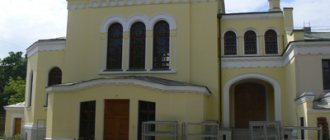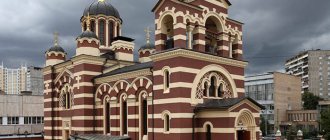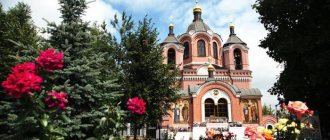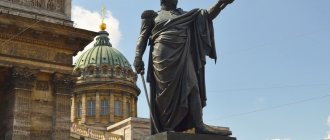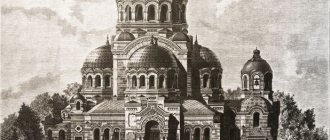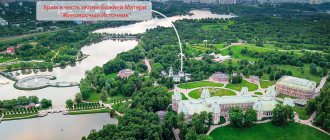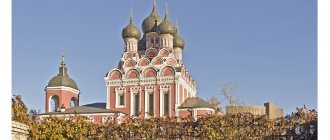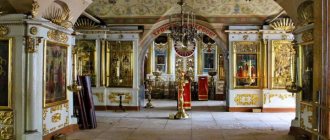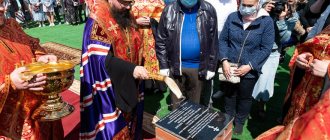The Church of the Icon of the Mother of God “Quick to Hear” is, without exaggeration, the main attraction of Upper Sanarka. A religious building appeared on the map of a small village in the Chelyabinsk region not so long ago - in 2005. In July of the same year, the temple was consecrated in the name of the icon of the Mother of God “Quick to Hear.”
Construction work began three years earlier - in 2002. They say that the initiator of the idea was the former governor of the Chelyabinsk region, Igor Sumin. More likely, not even he himself, but his wife Olga. The money for the construction was allocated by the Blagovest charity foundation, which attracted funds from both large local businessmen and donations from ordinary South Urals residents.
It cannot be said that the temple became the first religious building in Upper Sanarka. Before him, a chapel and a church already existed in the village, named in honor of St. George the Victorious.
The previous temple was built in 1899. Unfortunately, it has not survived to this day - it suffered the fate of most similar buildings: during the Soviet years, the bell tower was destroyed, the iconostasis was broken, and the ministers were expelled. Then the church was turned into a club, and after some time it was completely dismantled.
© Chelyabinsk Metropolis on VKontakte
Architecture of the Sanarsky temple
The religious building stands out for its architecture in the style of Russian wooden architecture.
If you thought about building in the spirit of the famous Kizhi, you were not mistaken - both attractions are really similar. For which, in fact, the Church of the Icon of the Mother of God in the Chelyabinsk region was nicknamed “Ural Kizhi”.
To repeat the success of Karelian craftsmen and build a log house (the porch and stairs were built using conventional technology!) without a single nail, local craftsmen even went to them for training. The result pleases and impresses more than one tourist and parishioner. The temple made of pure pine, a material unusual for the Southern Urals, looks very attractive.
The construction of the 15-main temple required more than 700 cubic meters of calibrated logs, and the church site itself occupied an area of 5,000 m². To protect the Orthodox shrine from fire, the pine was treated with a special agent that protects against fire.
It’s hard to imagine now, but initially they wanted to build the church in Upper Sanarka out of stone. Employees of the architectural workshop of the Moscow Patriarchate convinced me, saying that wood would better emphasize the character of the Russian hinterland.
© StarXnRp
Interior
Specialists have thought through every detail. And even the fact that pine will darken over time and will harmoniously combine with the patina that sooner or later forms on copper surfaces.
True, they plan to clean the plaque in the near future, and re-hang the bells and redistribute them among the beams. It is quite possible that the building will acquire another, eighth bell - it was cast in Kamensk-Uralsky.
The interior decoration also looks quite organic. Zlatoust craftsmen worked on it. By selecting bright and rich colors, they were able to shade the logs and achieve a glowing effect that supposedly emanates from the wall with icons. Only the ceiling was decorated with paintings.
Interior decoration, © Chelyabinsk Metropolitanate on VKontakte
Quick to Hear in Anisovka
How are churches and parish communities born - where they did not exist before, where they never existed, perhaps? Through whose efforts does faith suddenly flourish - in remote villages, in seemingly desolate provincial corners? Where do these simple people, not at all spoiled by fate, get the strength to build God’s House for themselves, their children and grandchildren?
Temple in honor of the Icon of the Mother of God “Quick to Hear” in Anisovka
I passed the Anisovka station of the Volga Railway probably thousands of times: after all, all the trains from Asian and pre-Asian expanses go through it - to the Uveksky Bridge over the Volga, to Saratov and further to Moscow. That is why Anisovka played a very important role during the war and lived under the constant threat of bombing. A little more history: Anisovka was founded in 1894 as a junction station of the Ryazan-Ural Railway, and received its name because Aniskin or Aniskov Farm was located nearby. Perhaps its owner was a farmer named Anisim or a farmer named Anisya.
But not so long ago, for the first time in my life, I got off the train in Anisovka. It was a dark winter morning. The echo of the departed train - and silence, only a scant snow crunching under your feet: birch trees turn white in the fog, dogs appear like ghosts, it won’t be long before you find a person who will show you the way to the temple.
And in the church in honor of the icon of the Mother of God “Quick to Hear” it is already light and crowded. This is what I see from the outside through the narrow rounded windows. This church has an unusual appearance for our area; it is not without reason that it is called a Byzantine basilica; and I can’t believe that this is a former railway canteen.
There is still half an hour before the start of the liturgy. But here is a tradition: before the morning service, a group of parishioners reads an akathist to the Mother of God in front of Her image, called the Quick to Hear. I approach them, and they immediately hand me a printed akathist: “Will you read with us? From here..." Having never expected this, having just entered a completely unfamiliar temple, I immediately joined in his prayer:
“We are strangers and strangers on earth and, according to the words of the Apostle, are not the imams of the city that resides here, but to whom shall we resort, O Lady, in the sorrows of our journey, if not to You, O All-Good One?..
The priest appears, and everyone immediately comes to him for a blessing and a kind word.
The priest, Father Alexander Ermoshin, appears, and everyone immediately comes to him for a blessing and a kind word. It is immediately clear that the words “father” and “father” here are not just traditional addresses. A bell can be heard outside. Blessed is the Kingdom...
There has never been a church in Anisovka. But, of course, there have always been believers. In August 2014, the Volga Railway donated an abandoned canteen building to the Orthodox community of the Anisovka station. Until that moment, the believers had only an adapted prayer room; Priest Alexy Talalaev cared for the community.
Over the 10-15 years of our timelessness, the canteen building fell into a terrible state, and then a fire happened - after the community, led by Father Alexy, began little by little repairs.
“After the fire, our wings dropped,” says veteran of the Anisovo temple construction, Maria Tarasovna Shinkorenko, “we thought, that’s it, we won’t have a temple now.” But then Father Alexander was just sent to us, and we continued our work. They cleared the area of thickets and weeds - how many trees they uprooted, how many fires they burned! And then they started raking and disassembling everything inside...
Of course, not everything was up to the Anisov community. Unusual in appearance and warm inside, the Anisovo church is the fruit of the joint work of parishioners, priests, donors and the archpastor - Bishop of Pokrovsky and Nikolaevsky Pachomius, to whom I, having returned from Anisovka, asked the question:
– Lord, why did the temple take on this appearance?
– This was due to the design of the building. We just looked and thought what we could do with it. I asked our diocesan architect Andrei Ivanov to look for options for transforming it, turning it into a temple. And we settled on this one, which has Byzantine features. Soon we will have several more unusual churches in our diocese.
The outwardly unusual Anisovo church is the fruit of the joint work of parishioners, priests, donors and the archpastor
Bishop Pachomius loves the Anisovo community and respects its abbot, whose difficult spiritual path we will talk about below; the archpastor is truly proud of these people, as evidenced by his page on the social network - and if anyone doesn’t like the word “proud,” then we can say that Bishop Pachomius is simply happy for them.
According to Father Alexander, it was possible to remake the “face” of the building in one season - thanks to a donor who prefers to remain anonymous, and who (again, the expression of the rector’s father) “not only has the means, but also love in his heart”; and, of course, thanks to the friendly and completely free team of parishioners:
– Some of them are no longer with us. Valentina Iosifovna Yakovenko - she was such a generous old lady, she baked such delicious pies until the last... Selivanova Galina Yakovlevna, also went to the Lord... Kondratyeva Valentina Emelyanovna - she did not come today because she was sick. And Ekaterina Yakovlevna Trokhanenko, she is 82 years old, is also sick; and she did a lot here. But Viktor Vladlenovich, a refractory mason and builder of industrial furnaces, was the first to examine the brickwork that we inherited.
The Anisovo community is of different ages, with very young people next to the elderly:
– This is Seryozha - he and I first came here together, when there was still devastation here. And this is Sasha and Tanya Rakov, spouses - they are on the choir.
Sasha, it turns out, makes a living as a carpenter. And here he is simply irreplaceable. Like everyone, probably... And today guests helped in the choir - parishioners of the Assumption Church, where Father Alexander served before. However, they are against being called guests: “We are all our own!”
They are against being called guests: “We are all our own!”
The service had already ended, but the parishioners had not left. This is also a tradition: after the Saturday or Sunday liturgy, there is a joint meal. The chef is also her own and also completely free - Lyudmila Khalilova: “Father blessed, so I prepare the meal,” it is clear that she is happy about this.
“Father Alexander, ” I ask, “ you have a very kind, open parish.” Did it happen on its own or was it somehow programmed?
- What do you! How can I educate adults? They are like that.
Parishioner:
- Marina! We want us to have a big, big parish! So that everyone comes to us.
I ask how the tradition of reading and singing the akathist before the liturgy developed. Father Alexander:
– When I was still an altar boy in the Church of the Resurrection of Christ, the rector, Archpriest Alexander Milovanov, blessed me to come to the church on Saturday and read the akathist before the icon of the Mother of God before the service began. And somehow this really touched me... I love praying to Her; We receive great help and intercession from Her. And here I proposed this to the parishioners, and they happily agreed, because they also love Her.
– Father, I know that you have not been in the Church from a young age, that you did not come to the priesthood right away. What is your occupation?
– Power engineer, high-altitude installer. Built high-voltage lines. In 2002, at the age of 33, I came to church for the first time - to the Holy Trinity Cathedral in Saratov. Father Gennady Belyakov, now deceased, served there at that time. He listened to me with great love, and his words remained in my memory for the rest of my life: “If I had a pill for all your troubles and problems, I would give it to you now. But I don’t have such a pill. The Church has the sacraments of Confession and Communion - come tomorrow.” This is how I confessed for the first time and received Holy Communion. Since 2009, he served as an altar boy in Novouzensk, where he then lived - in the Church of the Holy Great Martyr Catherine, with Father Alexander Milovanov. He came from business trips and was in a hurry to go to work.
The decision to serve Christ in the priesthood came several years after the first Confession. In January 2016, at the age of 47, Alexander Ermoshin was ordained a deacon by Bishop Pachomius of Pokrovsk and Nikolaev, and a priest in March of the same year; Graduated from seminary in 2018. Father Alexander is simple, laconic, he answers my questions briefly... but very succinctly, in fact.
– Wasn’t it difficult at a late age to step over such a threshold and take a one-way ticket?
- Difficult. But the Lord strengthened.
– What is the most difficult thing now, in your ministry today?
– Fight your passions.
- And the most joyful thing?
– Seeing the happy eyes of parishioners. Help them. When someone managed to help someone in some way, this is the greatest joy. But this is not my merit, of course, this is the will of God.
And here the parishioner intervenes again:
- When you arrive, we run to you like that...
“Yes, it makes me very…” here Father Alexander doesn’t find the right word, “in general, I can’t get used to it—to the way they greet me, to the way they see me off when I leave.”
– You, among other things, are also a teacher at the Orthodox children’s camp “Gardarika”. How do young parishioners differ from adults, what is their peculiarity?
– Children are sincere, open, they do not yet have the habit of sin, or internal compromise with it. They may, of course, stumble, but they can deeply repent at Confession. Our children have a lot of love and compassion - if they see a baby who has burst into tears simply because he misses his mother, they immediately look for something to console him with, they can give him some thing dear to them. This sacrifice in children really touched me.
I listen to Father Alexander, I listen to the parishioners - and I think that this, perhaps, characterizes the entire Anisovo community: they also have no habit. Habits to church life (although many of them have been in it for a long time), habits to each other... They are no longer children, but their perception is fresh, like that of children, and so is their faith.
Yes, today there are not many people here in the church, if compared with the entire population of the village near the station, but everything that I saw and heard here gives me hope: there will be a “big, big parish” over time.
Divine services and shrines of the “Ural Kizhi”
Prayers in the church are read on Saturdays and Sundays (morning liturgy) and on church holidays. On the last day of Easter the bells are allowed to ring.
Pilgrims from Plast, Borisovka, Magnitogorsk and Chelyabinsk often come here. Some people look in while passing through - the wooden building is clearly visible from the Yuzhnouralsk-Magnitogorsk highway. There is enough space for everyone: the church can accommodate 300 people.
In the church you can venerate the relics of Peter and Fevronia and other Orthodox saints. Also kept here is a copy of the ancient icon of the Mother of God “Quick to Hear.” The original miraculous image is located on Mount Athos.
Porch and stairs, © Polina P
Story
Mochische is a railway station in the Novosibirsk region, which appeared on the map of Russia due to the construction of the Trans-Siberian Railway. To accommodate the people who carried out construction and maintenance work on the site, barracks were built along the road. Gradually, Mochishche station grew as new people arrived. The fate of one family is related to the opening in Mochische of the Church of the Most Holy Theotokos in honor of the icon of the Novice.
The Idashins came to the village of Mochishche in 1903 from the Simbirsk province. For their living, a spacious house was built near the intersection of railways and highways. By the standards of the authorities in 1930, the Idashin family was recognized as wealthy, and therefore was completely dispossessed and the house was transferred to a commoner. But the size of the building was large and therefore they decided to transfer the building to an elementary school, which remained on the premises until the 50s, when a stone school was built for children.
The Idashins' house remained empty, but over time it was dismantled to the ground. A few years later, they decided to build a nursery garden on a vacant lot. Two log houses were erected. The result was a spacious room, which local organizations refused to take on as a children's institution. The building stood abandoned until 1974, when it was given over to a pharmacy.
In 1991, residents of the Mochishche station observed a miraculous phenomenon: rays approaching the center of the station from the eastern part, shimmering in different colors, reminiscent of a rainbow. An unusual light stopped right above the pharmacy building. Local residents took this phenomenon as a sign to found a temple for believing residents.
Women who dreamed of opening a church in Mochishche took up the issue of permission to transfer the pharmacy building into a church. The blessing for the opening of the church was given by Bishop Tikhon, who was the archbishop of the Novosibirsk diocese. This event coincided with the Orthodox holiday of the veneration of the icon of the Most Holy Theotokos of the Quick to Hear (November 22, 1993), which was the reason for the name of the church.
For permission to use the pharmacy premises for the temple of the Icon of the Quick Hearer, residents went to Novosibirsk, knocked on the doorsteps of the local administration, collected signatures of people who agreed to build a church in Mochishche. As a result, a positive result was obtained and with the help of material support from local residents and organizations, repair work began.
In 1994, Archbishop Tikhon of Novosibirsk blessed the opening of a church in honor of the icon of the Most Holy Theotokos Quick to Hear.
In 1995, Father Alexander Novopashin visited the temple at the Mochishche station in the Novosibirsk region and donated to the temple the icon of the Quick Hearer, with which a miracle happened some time later. The icon had a nondescript, shabby appearance due to its age. But the dean father told the parishioners that he had hope that the icon would shine with a new light in the church. The self-renewal of the icon of the Mother of God of the Quick to Hear occurred a few months later in 1996 on the day of Epiphany Eve.
Gradually, the church in honor of the icon of the Quick Hearer was built. A bell tower, a bookstore, a refectory, a Sunday school and other auxiliary buildings were attached to the main building. In 2005, a dome and a cross were installed on the bell tower. This event was marked by a mysterious phenomenon - in the sky above the temple, parishioners observed a rainbow, which appeared on March 18. This phenomenon confirmed the correctness of the intentions of the believers from the Mochishche station to open a temple in their locality.
Photos
For a general idea of the temple at Mochishche station in the Novosibirsk region and the shrines of the church, you can study the following photographs of the building of the shrine, revered by local believers and pilgrims:
Temple shrines
Residents of Mochishche, nearby settlements, guests from other cities and regions of Russia visit the temple to pray and touch two shrines of the parish:
- The icon of the Most Holy Theotokos Quick to Hear, revered by Orthodox believers as a shrine that helps everyone who asks the Mother of God from a pure heart. In the church at Mochishche station, located near Novosibirsk, there is a copy of the miraculous image of the Most Holy Theotokos Quick to Hear on Mount Athos.
- The Iveron Icon of the Most Holy Theotokos is revered as an image that exudes to the world and carries a special fragrance around. Helps everyone who asks to get rid of all kinds of diseases.
There are other shrines in the temple: St. Nicholas the Wonderworker, the image of the Savior Pantocrator, Jesus Christ in the crown of thorns, the icon of Seraphim of Sarov.
